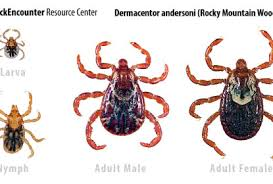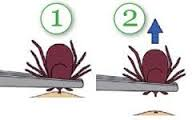 Finding a tick on your pet can be very scary. Ticks are known to carry nasty diseases which can make us or our pets very sick. If you live in or visit an area which could potentially be tick infected its important to check your dog immediately. Time is of the essence when detecting a tick. Be sure to check ears ( inside and out) and around the eyes very thoroughly in your full body inspection, as these are 2 of ticks favorite camp outs on our pets.
Finding a tick on your pet can be very scary. Ticks are known to carry nasty diseases which can make us or our pets very sick. If you live in or visit an area which could potentially be tick infected its important to check your dog immediately. Time is of the essence when detecting a tick. Be sure to check ears ( inside and out) and around the eyes very thoroughly in your full body inspection, as these are 2 of ticks favorite camp outs on our pets.
There is a very simple set of steps to remove a tick. The first very important step is protect yourself and wear gloves! Do not handle the tick at any point either during the extraction or during the killing. Simply touching the tick could make you sick and even contract Lyme disease. When removing the tick it is important to use either fine tipped tweezers or specialized tick removal instruments, not your fingers! Using your fingers even in gloves can apply too much pressure and stress or injure the tick forcing harmful juices into your dog. This should be avoided using the proper tools!
 A tick buries its face and mouth into our pet to feed. Its body will be sticking out. When removing a tick its very important to grab it by the head and NOT the body. If you grab the body and pull you could end up crushing the tick and forcing harmful bacteria right into your pet.
A tick buries its face and mouth into our pet to feed. Its body will be sticking out. When removing a tick its very important to grab it by the head and NOT the body. If you grab the body and pull you could end up crushing the tick and forcing harmful bacteria right into your pet.
The tick is not going to move or run away when you try to extract it . So take your time and get a firm grip on the head which again is the part that’s entering the skin. DO not jerk, twist or do anything to try to loosen the tick. Simply pull firmly and steadily in the direction outward from the skin. In about 20 to 30 seconds, the tick’s mouth will release its grasp and the tick will come away cleanly.
Clean the bitten area on your pet with a disinfectant or triple antibiotic ointment.
Once removed keep in mind ticks cannot be killed by flushing down the toilet. You need to put them in a jar of alcohol to kill them. The ONLY way to kill a tick is alcohol. Once you remove and kill the tick it’s a good idea to keep the tick. Secure him in a sealed plastic bag (dead please). Why do I suggest this? If your dog ends up becoming sick it will help your vet in a major way to know what species of tick bit your dog to begin treating him faster and more effectively. There are MANY different species of tick. Deer, Ixodes, Brown dog, American dog, Lone star, Rocky mountain wood, Gulf coast,to name a few. Most of us I’m sure have never even heard of half of those and even in describing what we removed from our dogs would probably not be accurate enough for our vet to guess. So remove the guess work and keep your tick!
Your pets skin may continue to show irritation or even permanent scarring in the area of the tick bite. It can take a few weeks for the area to return to normal or semi normal. This is not an indication you missed a piece. It is the normal healing process of the pets skin still reacting to the tick saliva. Keep in mind you may have a permanent bald spot in the bitten skin. That’s is normal.
Methods of tick removal to avoid:
DO not smother the tick with vaseline. This is very dangerous and not effective. Ticks only breathe 1x per hour so this method will take a very long time. Yes the tick will eventually back out of the skin with this method. BUT in the process with actually send all its gut contents into your dog as it suffocates. Forcing everything you don’t want in your dog directly into your dog. PLEASE do not try this method.
DO NOT twist or run circles over the tick to ” make it dizzy”. All your are going to accomplish is decapitating the tick and leaving the mouth inside your dog. A ticks neck is the weakest part of its body and it easily separate if you try this method. Leaving the head or mouth in your dog is just as bad as leaving the whole tick in there.
After removal of the tick. Keep an eye on your pet . As noted expect the area to remain a little soar or swollen for a few weeks. However if your pet becomes ill, see a vet immediately. Most tick related disease can be treated successfully if caught early. If ignored and allowed to gain strength, these bugs can cause serious illness, even death.
Please be proactive. Monthly flea and tick preventative should always be used, and yearly Lyme disease vaccinations completed. You can never be too careful in protecting your pets from nasty diseases.









